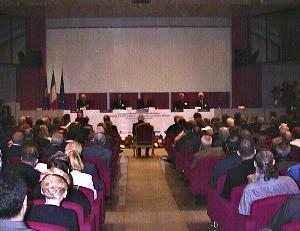 |
At 4:00 p.m. on June 5, 1998, at the Unione Industriale in Turin, Italy, the Third International Congress for the Study of the Shroud of Turin, with the theme "Shroud and Science," opened to a packed auditorium. Sponsored by the International Center for Sindonology in Turin, the Congress was officially opened by the Honorable Oscar Luigi Scalfaro, President of the Republic of Italy, and Cardinal Giovanni Saldarini, Archbishop of Turin and Pontifical Custodian of the Shroud.
But the story of the Symposium actually begins over a year earlier, in January of 1997, when the Organizing Committee first distributed a registration form for the event to sindonologists worldwide. I received my copy in March 1997 through the courtesy of Professor Nicolò Cinquemani of the Hospital of S. Giovanni in Rome. The form indicated a May 31, 1997 deadline for submission of the title of any paper one might wish to present. I immediately mailed my completed form, along with US$150.00 in payment of the registration fee, and waited for a response.
Finally, after nine months of silence, in January of 1998 all registrants received a fax from the organizers asking them to submit an abstract of their papers. We were told that, "the International Scientific Committee will meet in a few weeks to examine and evaluate for acceptance all the contributions to the Congress." The implication was that all abstracts would be screened by the eminent scientists on the committee and that only qualified papers would be accepted for presentation. (This is typical of most symposiums and was actually expected by most of the researchers planning to participate). This request prompted me to get busy and finish writing the abstract I had been putting off for a full year. I finally submitted it via fax in early February. Then, silence again.
As time progressed without any word or acknowledgement, this lack of response from the Symposium's organizers became a common topic of discussion in the many e-mails I received from Shroud researchers around the world. As the weeks slipped into months, everyone with contacts in Italy attempted to find out the status of the Congress and more importantly, whose work had been accepted and whose had been rejected. We were told time and again that a schedule of accepted papers was forthcoming in "two weeks" and that we should be patient. So we waited again.
As May came to a close with the Congress only one week away, it became obvious that this schedule was not going to be provided. In essence, nearly one hundred researchers from around the world had to make reservations to go to Turin without even knowing whether they would be given an opportunity to speak. This did not bode well to the many scientists who submit and present their work to similar symposiums on a regular basis. Yet nearly every researcher who had submitted an abstract trusted the organizers, made their reservations and traveled to Turin.
As we gathered in the hotels and restaurants of Turin in the days before the opening of the Congress, the primary topic of conversation amongst the researchers was whether "anyone had heard anything" about the symposium. There was still nothing to indicate who would speak and who would not.
Finally, the opening day of the event dawned to an overcast sky and the oppressive humidity common to Turin in the summer. We began to assemble in the courtyard of the Unione Industriale an hour or so before the scheduled 2:00 p.m. start of the event, everyone clustering into small groups, thrilled to see old friends or meet new ones. As we stood around and waited for the doors to open, the main topic of conversation remained the same: "Has anyone heard anything about the schedule of events?"
It was then that I was approached by Chris Matthews, the colorful, Oxford educated Rome correspondent for Reader's Digest. He explained that the magazine was planning an updated article on the Shroud, the first since they excerpted John Heller's book, "Report on the Shroud of Turin," in 1983. He wondered if I would review the schedule and suggest which papers I thought might be important ones for him to hear. In his hand was a ten page list of all of the researchers with the scheduled days and times of their presentations!
"Where did you get that?" I asked in amazement.
"In the press kit from the organizers," he replied casually, probably wondering why I reacted so dramatically.
For reasons I still don't understand, the media was given the schedule before the researchers themselves learned if they would present their work. I excused myself momentarily to mention it to John and Rebecca Jackson, standing nearby. Their eyes grew wide as I told them what I had just seen and who I got the information from. Their next question was, "Are we on the list?"
This scene repeated itself several times as I gave the news to Dr. Alan Adler, Dr. Fred Zugibe, Isabel Piczek, Dorothy Crispino, Professor Dan Scavone and others. Amazingly, the organizers had failed to make this information available to anyone other than the media! It was not until another hour or so had passed and we braved a very long line to register that we were each finally given a blue canvas briefcase that included the complete schedule of the symposium. Everyone immediately opened their packets and searched to find their names on the schedule.
And what did we find when we finally consulted the list? That everyone who had submitted an abstract was scheduled to present! On the agenda for the two and a half day event were 104 different papers scheduled for presentation by almost as many researchers! It was obvious from the titles of some of the papers and the sheer number of them that there had been no screening at all.
The next question on everyone's lips was how they could squeeze so many papers into such a short period of time. The answer became quite obvious as the first of the presenters walked to the podium an hour or so later.
"Eight minutes," he was told. And that would set the pace for the next two and a half days. The researchers had traveled thousands of miles with no confirmation of the acceptance of their papers, only to be told at the last minute that they would be limited to eight or ten minutes of presentation time. After months or even years of research and preparation, their presentations would be severely restricted. And several presenters, who apparently failed to meet some unnamed criteria were told, "four minutes!"
To add to the frustration, sessions were scheduled simultaneously in two different halls, making it impossible to attend many of the presentations one had hoped to hear. Apparently, this was either not taken into consideration by the organizers, or they decided to use this as a solution to the massive time problem created by the complete lack of screening prior to the symposium.
To complicate matters even more, some presenters were so intent upon delivering their entire work that they ignored the clock and took more time than they were allocated. Of course, this is understandable when one considers the pressures of trying to present a thorough, professional paper in front of one's peers and having to speak at triple speed in an effort to include everything. In one case, it was only after the microphone was turned off by an irate session leader that the embarrassed researcher finally surrendered the podium and allowed the next presenter to speak. Time limits became such a common problem that they resulted in the schedule being constantly shifted and juggled. Many sessions ran late and were terminated before all the scheduled papers were presented, causing some presentations to be rescheduled to even later sessions. Sound confusing? Trust that it was. It was very difficult to find and hear the specific papers you were interested in. This could easily have been avoided by providing a centrally located bulletin board with an official schedule posted on it that indicated any last minute changes.
In all fairness, I should add that Professor Baima Bollone, the Chairman of the Organizing Committee, went through a period of serious illness during the past year and we are all thankful for his recovery. Still, it is difficult to understand why matters weren't handled in a more organized and professional manner by the other committee members. The realm of Shroud research rarely gets such an opportunity to bring together the finest Shroud scholars in the world. It should have made better use of their time.
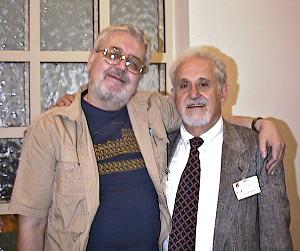 |
On the other hand, the presence of such a diverse and expert group of Shroud researchers was also the highlight of the event. I was personally delighted to finally meet so many of the researchers I only knew through written correspondence over the past few years and so many who I had always hoped to meet. These included such eminent sindonogists as Dr. Alan Adler, Mark Antonacci, Alexander Belyakov, Fr. Aram Berard, Professor Nicolas Cinquemani, Dorothy Crispino, Avinoam Danin, Albert Di Giglio, Giulio Fanti, Anna Ferrer, Dr. Leoncio Garza-Valdes, Aldo Guerreschi, Dr. Gildas Heras, John Iannone, Michelina Le Margie, Jack Markwardt, Dr. Alan Mills, Serge Mouraviev, Adolfo Orozco, Fr. John-Peter Pham, Keith Propp, Barbara Sullivan, Remi Van Haelst, Dr. Frederick Zugibe and my dearest friends, Emanuela and Maurizio Marinelli and Maurizio's beautiful wife Simona. As I wrote out this list I realized just how many of those names have also been significant contributors to the Shroud of Turin Website. I am truly honored and sincerely grateful.
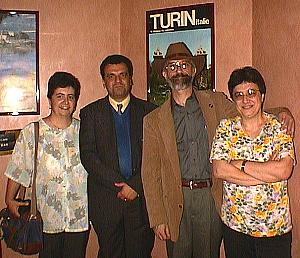 |
Of course, there were also the researchers who are old and dear friends, many whom I see quite regularly and some that I haven't seen in fifteen years. This list also reads like a "Who's Who" of Shroud research and website contributors: Russ Breault, Rev. "Kim" Dreisbach, Dr. John and Rebecca Jackson, Dr. Gil Lavoie, Dan McPherson, Paul and Lois Maloney, Joseph Marino, Kevin Moran, Rex Morgan, Isabel Piczek, Professor Dan Scavone, Dr. Alan and Mary Whanger and Ian Wilson. And I'm sure in my haste to complete this article I have undoubtedly overlooked someone, so forgive me if I failed to include you on this list and you belong there.
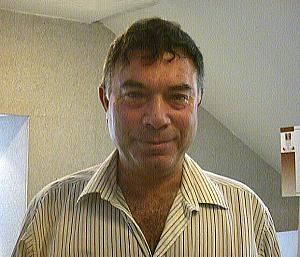 |
Noticeably absent and sorely missed were Dr. Robert Bucklin and Michael Minor, who were planning to jointly present a paper. Mike has been seriously ill over the last few months and was unable to attend, although we are thankful to hear he has improved recently. Under the circumstances, Bob decided to postpone delivering his portion of the paper. Everyone sends their best wishes to Mike for a speedy and complete recovery. And particularly missed was Richard Orareo, owner and curator of the Boston Collection. Richard had visited Turin in April for the opening of the Exhibition, (see two articles he wrote for the website on the "Shroud Exhibitions" page) and sadly, was unable to return for the Symposium.
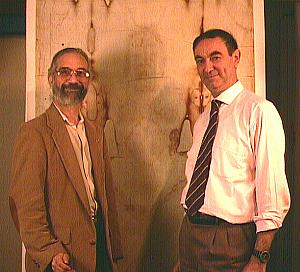 |
One of the greatest pleasures I had was meeting Italian professional photographer Aldo Guerreschi, owner of Studio Scoffone and adminstrator of the 1931 Enrie photographs. Aldo and I both felt privileged to be part of the very small group of living photographers ever given permission to officially photograph the Shroud. I first met him at the symposium, and then, through the kindness and generosity of Emanuela Marinelli, (who spent 7 1/2 hours traveling on a train from Rome to Turin just to act as our interpreter), met him again at his studio. The meeting was one of several we ultimately had during my visit, and led to a pledge from both of us to actively cooperate with each other and share our materials. I felt it was a true step forward and we both hope it sets an example of cooperation between Italians and Americans for future Shroud research.
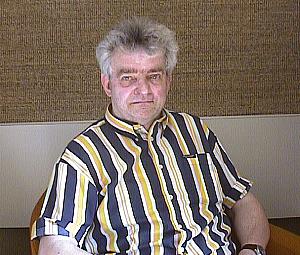 |
Of course, the papers presented at the Congress are the most important part of the event. It is within these papers that the future of Shroud research lives. It is where new ideas can be found and earlier ideas can be evaluated. It is where the results of the latest Shroud research is made public for the first time. A number of papers were presented that will certainly create interest (and controversy) in the world of the Shroud. Two of these dealt with the radiocarbon dating of the Shroud, one presented by an Italian team of researchers and the other by an American group. In both cases, researchers examined the effects of high temperature on the resultant carbon dates of linen cloth. This was done to simulate the effects of the 1532 fire that severely damaged the Shroud and evaluate the impact such exposure could have had on the cloth. Both groups independently concluded that subjecting linen to high temperature can impact radiocarbon 14 dating results significantly.
Several papers criticized the 1988 carbon dating for its omission of an apparently critical chemical analysis of the samples prior to the testing. They also disputed the conclusions of the tests that claimed a "95% certainty" for the resulting medieval datation of the Shroud. Quite a number of papers dealt with various theories of image formation and some proposed new formation mechanisms. Others proposed new forms of image analysis and some proposed new spectral imaging and photographic experiments. There were many papers dealing with the historical, medical and religious elements of the Shroud, but only a handful of papers dealing with Shroud conservation, supposedly the primary area of research planned for the immediate future. Somehow I expected it to be one of the largest categories. Frankly, there was only a modest amount of really new work presented and I noticed a rehashing of old material and ideas in a number of papers.
Still, there were many interesting presentations made during the symposium (far too many to mention in this article) and it is my hope to eventually publish all of them on the website. My own paper, "The Role of the Internet in the Future of Shroud Research" is already on the site and many other researchers have provided me with digital files of their work. These will be added to the website in the near future. Every researcher who presented at the Congress is invited and encouraged to submit his or her papers for publicaton on the site. This will give everyone an opportunity to read the full presentations at their leisure. See the "Scientific Papers & Articles" page for detailed instructions and submission requirements.